August 31, 2003
A 50 MegaPixel Camera
The PS3200 is a flatbed scanner with a transparency attachment, capable of 3200 dpi scans on 35mm, medium format and 5x4 negatives and transparencies. I recently bought one when I discovered that there are now affordable scanners for medium format negatives, the lack of which had previously, and stupidly, limited my forrays into digital photography.
Physically the scanner seems pretty solid, though the inserts that hold the film to be scanned are a bit flimsy. Installation is easy, my copy of PhotoShop 7 happilly firing up the SilverFast software. Scanning is quite slow, largely I suspect, to my connection being through old style USB 1. USB 2 or FireWire could be significantly faster. I'm scanning at 3200 dpi, 8bit greyscale - this gives a file of about 50Mb - i.e. in effect a 50 megapixel camera. The software offers scanning at 6400 dpi - but I think that is interpolated, there being no real information in the extra data. 50 MB images (150 MB if I convert them to colour) are quite large and pushing the performance and memory capacity my desktop computer. After PhotoShop crashed from lack of memory, I increased computers virtual memory to 2GB. I don't think more resolution would be useable with my current, admittedly rather old, computer set up - 800MHz P4 with 128 MB of memory. (I've since increased the memory to 384 MB which improved performance considerably, howerver installing a USB 2.0 card did little to speed up scanning.)
Scanned 2 1/4 square inch negs look great on the screen - bitingly sharp and georgous - though some more than others. 35mm transparencies look pretty good too. The scanned images tend to have quite a lot of dust on them. I'm blowing the negative with canned air before scanning and I;m also blowing the bed of the scanner, but there is still a lot of crud left. Of course it can be touched up in PhotoShop, but I'd rather not have it there in the first place. Something to learn how to avoid.
I'm pleased with results so far. I've tried printing some images on an old HP 1120C printer on A3 sized paper. The printer is from a generation before HP got serious about photographic printers. Some of the results are quite pleasing - sepia tone soft nudes and portraits look good when printed on ordinary artists cartridge paper from an a sketch pad. However, if I'm going to take printing seriously I will have to buy a modern photographic printer.
August 13, 2003
A red sky in the morning and a red sky at night
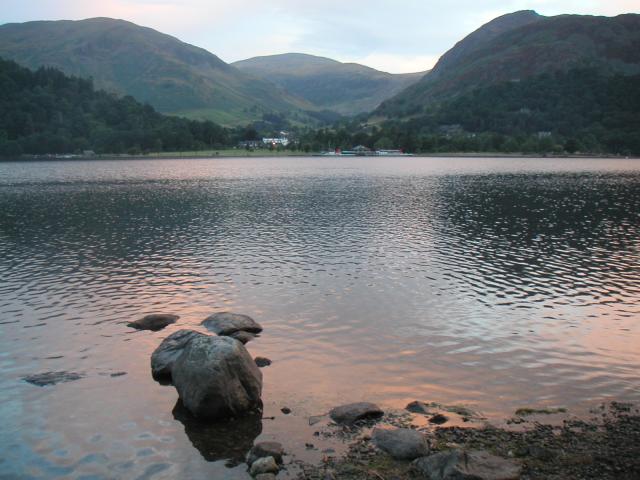 This is a view across Ullswater in the English Lake District, from Side Farm campsite towards Glenridding. The water reflects the bright pink colour of low clouds lit from below by the rising sun.
This is a view across Ullswater in the English Lake District, from Side Farm campsite towards Glenridding. The water reflects the bright pink colour of low clouds lit from below by the rising sun.
I am not usually awake before dawn, let alone up, dressed and out admiring the view. The ground at Side Farm is hard, the rock under my hip bone harder, and getting up for an early morning stroll preferable to lying awake on both. As I watched the progress of dawn, a flockof geese flew by, landing noisily in the water a hundred metres north. More serenely, a family of swans, a male, a female and six cygnets swam warily past.
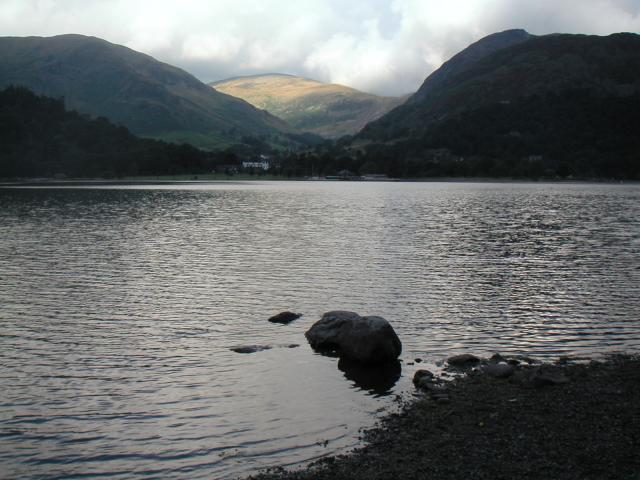 As the sun rises it must clear the hills to the east before warming the ground below. First it lights the distant hills to the west, and as the minutes pass, the shadow shrinks and the terminator creeps down the hillside to the opposite shore, lighting the steamers in their berths before setting out across the lake, until, at around nine o'clock, starting to dry the dew condensed on our tent.
As the sun rises it must clear the hills to the east before warming the ground below. First it lights the distant hills to the west, and as the minutes pass, the shadow shrinks and the terminator creeps down the hillside to the opposite shore, lighting the steamers in their berths before setting out across the lake, until, at around nine o'clock, starting to dry the dew condensed on our tent.
I love the Lake District. Camping there is the best holiday; the fastest way I know to relax. Every little action in camp requires care; a wrong move can have lasting effects on comfort. A wrong word to one's companions can have a similar effect. There are few plans to make, few goals to attain and few uncertainties all of which lead, with the help of good equipment, good food and good wine to rest.
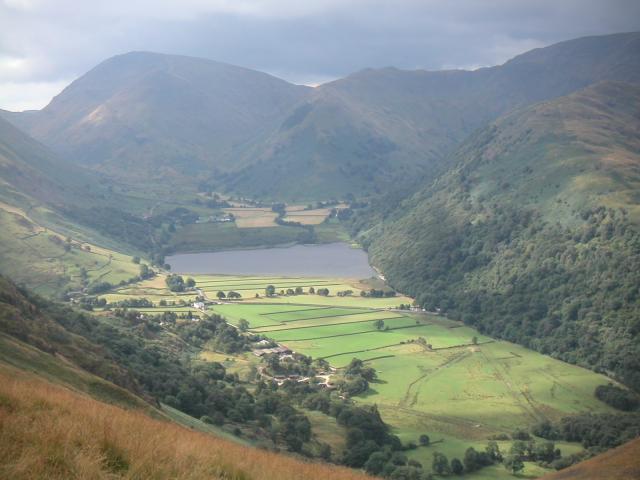 After breakfast, Janet, Ian and I set out up the hill to the east over which the morning sun has recently appeared to walk to Angle tarn. The hillside is steep and before long we enjoy the view south over Brother's Water to the Kirkstone Pass. The day is cloudy with gaps through which the sun lights up segments of the landscape. In this image, the hills are in shadow and the green fertile fields of the valley floor highlighted.
After breakfast, Janet, Ian and I set out up the hill to the east over which the morning sun has recently appeared to walk to Angle tarn. The hillside is steep and before long we enjoy the view south over Brother's Water to the Kirkstone Pass. The day is cloudy with gaps through which the sun lights up segments of the landscape. In this image, the hills are in shadow and the green fertile fields of the valley floor highlighted.
The hills and valleys of this region were formed by glaciation. The U-shaped valley typically formed by a glacier can be clearly seen. The flatness of the fields suggest that this land was once beneath the surface of a lake. The fields are flat because they were once silt on the lake bed. The lake has shrunk and untill all that remains is Brother's Water. I wondered if it will survive global warming and speculated about writing a story set after the Lake District has dried up. "Mummy, Mummy, why do they call this the Lake District?"
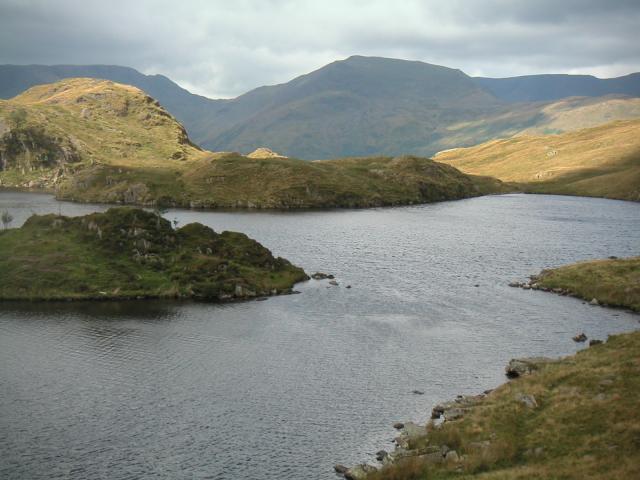 After a bit more than an hour of gentle trudging we reach Angle Tarn, where we stop to redistribute the weight from the rucksack Ian carries. We move the crisps (for salt), sandwiches, fruit and drink from his pack to our stomachs. Janet had started out carrying the pack, but as we climbed the hillside Ian took over as she found walking uphill more demanding than walking on the flat.
After a bit more than an hour of gentle trudging we reach Angle Tarn, where we stop to redistribute the weight from the rucksack Ian carries. We move the crisps (for salt), sandwiches, fruit and drink from his pack to our stomachs. Janet had started out carrying the pack, but as we climbed the hillside Ian took over as she found walking uphill more demanding than walking on the flat.
We had set out not sure how far we wanted to walk. We could have turned round after lunch, which we would do when we repeated this walk two days later, but on this day, walking back the way we came looked too boring and I had spotted a route, continuing to just below a hill called the Knot, down the hillside to Brother's Water and then back up the valley floor to our campsite. So off we set for the Knot.
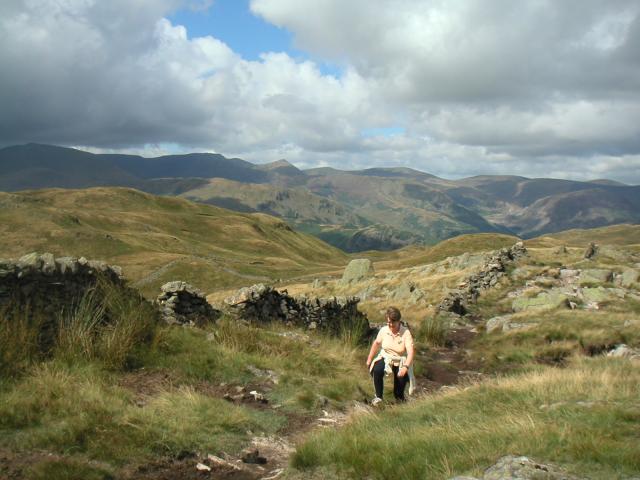 The going was flat and pretty easy. The clouds thinned, the sun shone and we enjoyed the beauty of the landscape as we walked on. I had three cameras with me. The small Minolta digital camera that took the pictures on this page, my old Olympus XA point and shoot film camera with its marvelous 35mm lens loaded with slide film and a medium format camera and tripod carried in a heavy backpack. That backpack was my burden and was, I think, the main reason I did not put on much weight on this trip despite the good eating and plentiful drinking we did in the evening. Several times, I took the same photograph with each camera to compare their effectiveness. Is it really worth carrying the weight of the medium format camera? I am contemplating buying a new scanner which can scan negatives upto 5 inches by four inches, which will temp me to get a field camera.
The going was flat and pretty easy. The clouds thinned, the sun shone and we enjoyed the beauty of the landscape as we walked on. I had three cameras with me. The small Minolta digital camera that took the pictures on this page, my old Olympus XA point and shoot film camera with its marvelous 35mm lens loaded with slide film and a medium format camera and tripod carried in a heavy backpack. That backpack was my burden and was, I think, the main reason I did not put on much weight on this trip despite the good eating and plentiful drinking we did in the evening. Several times, I took the same photograph with each camera to compare their effectiveness. Is it really worth carrying the weight of the medium format camera? I am contemplating buying a new scanner which can scan negatives upto 5 inches by four inches, which will temp me to get a field camera.
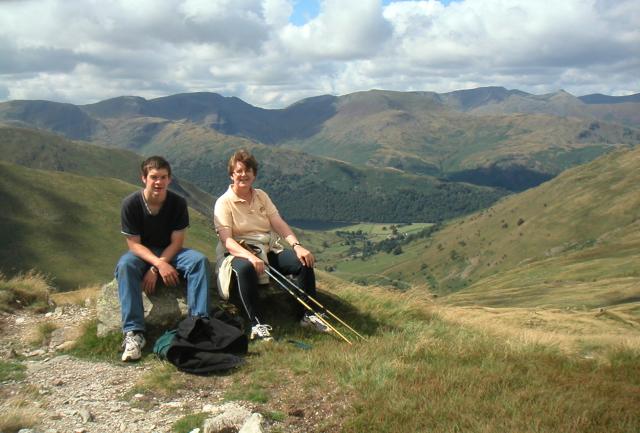 We walked on reaching the Knot where we rested and drank the rest of the water, after about another hour. The sun was shining strongly. We turned down the hill towards the valley where I was reminded that going down hill can be harder than going up. The going was steep and my knees were trembling and wobbly by the time we got to the bottom.
We walked on reaching the Knot where we rested and drank the rest of the water, after about another hour. The sun was shining strongly. We turned down the hill towards the valley where I was reminded that going down hill can be harder than going up. The going was steep and my knees were trembling and wobbly by the time we got to the bottom.
By the time we reached the bottom, I was tired and ready to stop, but we still had 3 to 4 kilometres to walk back up the valley floor. By now, the clouds had more or less disappeared; it was very hot in the valley floor and we faced a dilemma. We could walk up the main road which would take us first to the pub in Patterdale and I really fancied a cold beer (or two). Alternatively we could take a nearly parallel track which, being away from the traffic is safer and is a very little shorter. We took the track, and when we eventually got back to Side Farm we stopped at the tea shop and had tea and ice cream. Though highly desirable, the cold beer was just too far away.
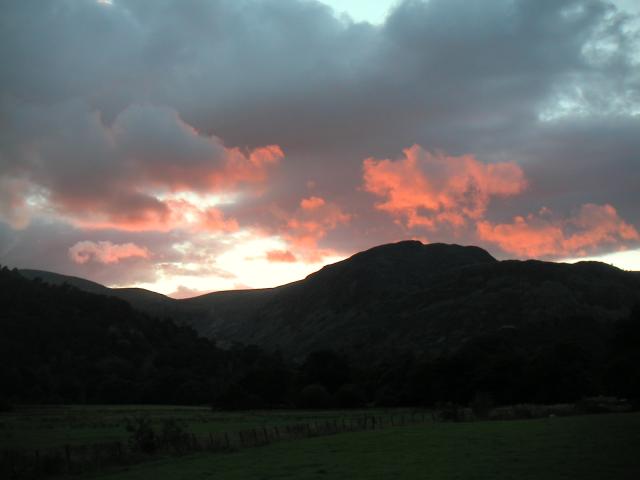 After a rest we had trouble with the stove (easily fixed the next day with some WD40) and went to the pub for supper (an experience I wouldn't recommend - try the Patterdale hotel.) After a meal and a bottle of wine, the sun had already set as we walked slowly back to the campsite. As we walked, I noticed that the set sun had turned the clouds a similar shade of deep pink as it had at dawn.
After a rest we had trouble with the stove (easily fixed the next day with some WD40) and went to the pub for supper (an experience I wouldn't recommend - try the Patterdale hotel.) After a meal and a bottle of wine, the sun had already set as we walked slowly back to the campsite. As we walked, I noticed that the set sun had turned the clouds a similar shade of deep pink as it had at dawn.
August 10, 2003
Sunday Afternoon, Blackwell's and Boston Tea Party
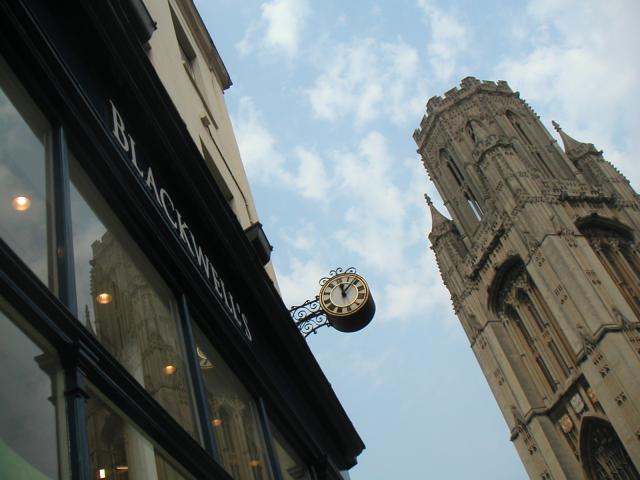 I have loved visiting bookshops since I was a teenager when I stood for ages before the shelves of blue penguins in the Dundee University bookshop, wondering which to buy. My bookshop experiences were enhanced considerably by the Printers Ink bookshop in Palo Alto, which, at the time I first discovered it, had a rather seedy coffee bar within. That it was seedy didn't matter, because it was a quiet, intimate place, with unusual people and served good coffee.
I have loved visiting bookshops since I was a teenager when I stood for ages before the shelves of blue penguins in the Dundee University bookshop, wondering which to buy. My bookshop experiences were enhanced considerably by the Printers Ink bookshop in Palo Alto, which, at the time I first discovered it, had a rather seedy coffee bar within. That it was seedy didn't matter, because it was a quiet, intimate place, with unusual people and served good coffee.
The Palo Alto shop had a sister establishment in Mountain view that also had a coffee shop, but located upstairs on a balcony. I once waited to be served there by an exceedingly good looking Californian girl. She was not tall, but of oriental ancestry and with short, (dyed?) blonde hair. Serving my coffee was delayed while she described in intimate detail to an earlier customer how an elderly tatoo artist had first shaved her then applied a red rose. Apparently, once her hair had grown back, the end of the stem was no longer visible and the rose seemed to grow out of dark undergrowth.
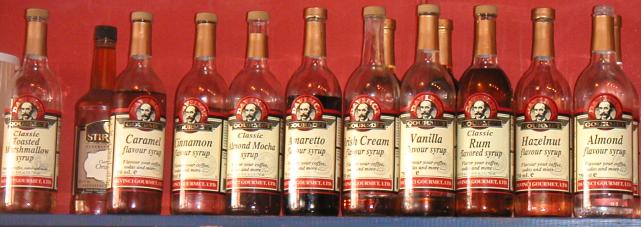 In the Mountain View shop one could sit at the edge of the balcony drinking coffee and observe folks browse the books downstairs. To my mind, the Palo Alto shop was spoiled when the dance school next door to it closed. The bookshop was extended and the seedy old coffee bar replaced by a trendy new one with much chrome and marble topped round tables. It became livelier and trendier and no doubt more profitable, but, unlike Boston Tea Party, it was no longer a restful place to drink coffee and read or chat to my son David as he drank an Italian soda.
In the Mountain View shop one could sit at the edge of the balcony drinking coffee and observe folks browse the books downstairs. To my mind, the Palo Alto shop was spoiled when the dance school next door to it closed. The bookshop was extended and the seedy old coffee bar replaced by a trendy new one with much chrome and marble topped round tables. It became livelier and trendier and no doubt more profitable, but, unlike Boston Tea Party, it was no longer a restful place to drink coffee and read or chat to my son David as he drank an Italian soda.
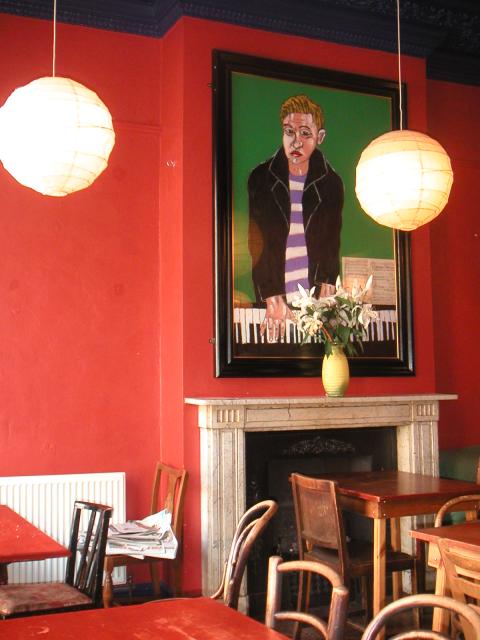 Boston Tea Party is currently my favourite coffee shop. It is to be found near the top of Park Street, Bristol. Ask for a large latte
Boston Tea Party is currently my favourite coffee shop. It is to be found near the top of Park Street, Bristol. Ask for a large latte![]() lf you go there. The staff pride themselves on making pictures and patterns in the foam of the coffee.
lf you go there. The staff pride themselves on making pictures and patterns in the foam of the coffee.
The interior has plain wooden tables whose scratched tops are painted red. There are three sofas. The old ones came close to causing injury and have been replaced, but here even the new looks old. The only chrome is on the well used expresso machines. This is a place where one can put ones feet up and read the Sunday papers in comfort. 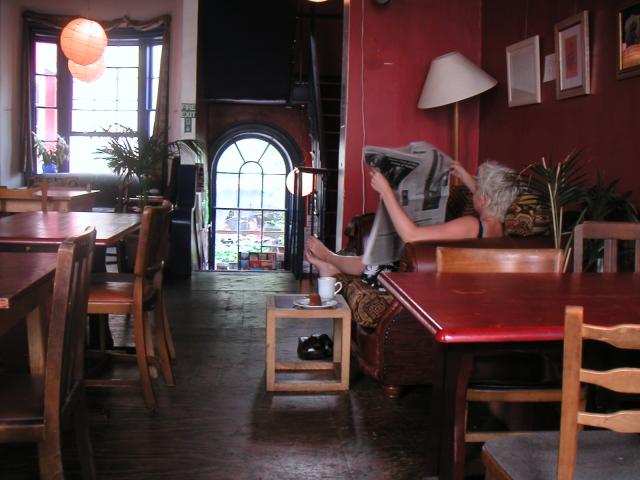 On a wet day it is heaving and full of people; richer students from the University, staff and middle aged folks like me who enjoy the atmosphere as well as the coffee, but on a hot summers day like today, the upstairs room is quiet and most folks are in the garden, visible through the window at the back.
On a wet day it is heaving and full of people; richer students from the University, staff and middle aged folks like me who enjoy the atmosphere as well as the coffee, but on a hot summers day like today, the upstairs room is quiet and most folks are in the garden, visible through the window at the back.
I still like to find time on a Sunday afternoon to browse around a good bookshop and then go for coffee. I feel comforable in Blackwells, conveniently located only a few doors up Park Street from Boston Tea Party. It is not quite a quaint old shop, split amongst many levels. The levels most visible levels from the street have recently been redecorated in the light, modern bookshop style, perhaps in response to the new Borders bookshop that has opened nearby.
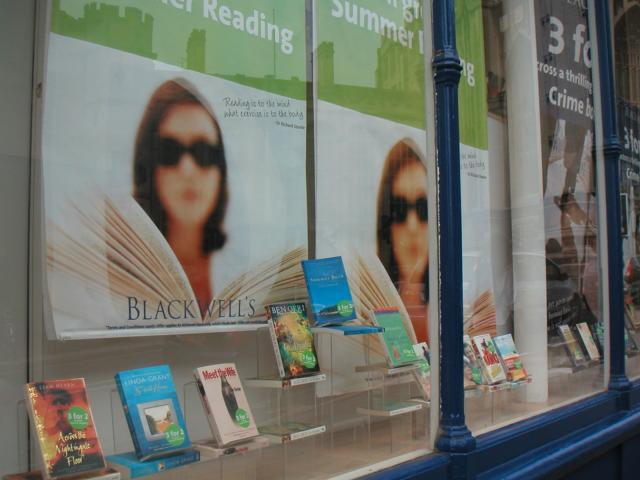 One of Blackwells levels is occupied by a coffee shop. It is very shiny with lots of chrome and metal. I have never seen it busy. I don't use it and can't imagine it being profitable. Its style just does not fit its host. Waterstones in Dundee does it right. There, like in Mountain View, the coffee shop is upstairs on a balcony permitting coffee drinkers to observe the bookshop below. There are newspapers and publishers review copies of books freely available for customers to read. It is dark with soft arm chairs and delightful.
One of Blackwells levels is occupied by a coffee shop. It is very shiny with lots of chrome and metal. I have never seen it busy. I don't use it and can't imagine it being profitable. Its style just does not fit its host. Waterstones in Dundee does it right. There, like in Mountain View, the coffee shop is upstairs on a balcony permitting coffee drinkers to observe the bookshop below. There are newspapers and publishers review copies of books freely available for customers to read. It is dark with soft arm chairs and delightful.
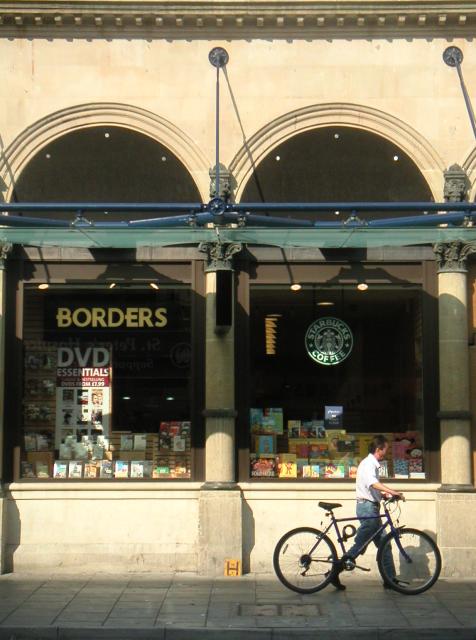 The nearby Borders is bigger, and since it occupies only two floors, looks it. It may be a clue that that upper floor has room for another StarBucks and a stationers as well as the entire collection of non-fiction, CD's, DVD's and videos. On asking where the biorgraphy section could be found, I was told they did not have one; biographies are spread around in the appropriate category. I wonder where one would find da Vinci. Compare that to Waterstones in Picadily, London, where, with a bookcase for each letter of the alphabet, the biography section occupies half (?) the ground floor. Sadly, many of my colleagues think it is superior, which leads me to wonder whether Blackwells will survive. A StarBucks coffee shop opened across the street from Boston Tea Party, a business strategy I have been told is common for that company. Up the street there is a Subway sandwich shop. The main facade of the university building (complete with nearby student prank) reflects in its window. American business has moved in.
The nearby Borders is bigger, and since it occupies only two floors, looks it. It may be a clue that that upper floor has room for another StarBucks and a stationers as well as the entire collection of non-fiction, CD's, DVD's and videos. On asking where the biorgraphy section could be found, I was told they did not have one; biographies are spread around in the appropriate category. I wonder where one would find da Vinci. Compare that to Waterstones in Picadily, London, where, with a bookcase for each letter of the alphabet, the biography section occupies half (?) the ground floor. Sadly, many of my colleagues think it is superior, which leads me to wonder whether Blackwells will survive. A StarBucks coffee shop opened across the street from Boston Tea Party, a business strategy I have been told is common for that company. Up the street there is a Subway sandwich shop. The main facade of the university building (complete with nearby student prank) reflects in its window. American business has moved in.
There are now three good bookshops in close proximity; perhaps they will attract more business to the area and all will do well. I first encountered the combination of bookshop and coffee shop in the US, but perhaps unfairly, I'm still rootin' for Blackwell's and the Brits.
August 05, 2003
Anniversary lunch
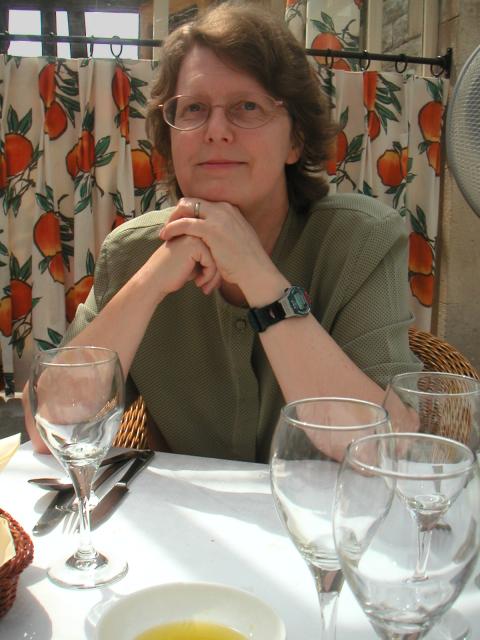 The 5th of August is my wedding anniversary. This year's is our 25th.
The 5th of August is my wedding anniversary. This year's is our 25th.
On my eldest son's 21st birthday we had a small ceremony in which we wished him well for life and gave him some gifts as symbols of the things we value that we hope life will bring him. I did the same for Jena on her, recent 21st and on that occasion, wrote down the speech I gave as a letter to her. Janet liked it, so I decided to write a letter to her on our anniversary. I gave it to her at our celebratory lunch. This is the text of the letter.
Janet,
It occurred to me that the occasion of our 25th wedding anniversary is as deserving of a brief note as the 21st birthdays of our children. You may argue that their situation is different; that they are just embarking on their adult lives whilst we are merely stopping for a brief rest on the way. But it seems to me that like a walk in the Lake District or a sunny day in the Alps as we break to eat our sandwiches, this is a good moment to look back down the path we have climbed, to enjoy the scenery in which we find ourselves and to look forward with pleasure to the rest of the outing.
From here, the path behind us looks mostly gentle, with only a few short stretches where we endured bad weather, or more more frightening for me, where the path narrowed with steep rocky falls on either side. It never got so bad that I had to sit down and refuse to go on; you have always supported me through the rough patches, which is not to say that there have not been times when you have told me not to be a bloody fool and just get on with it.
I hope you will agree that the view along the way has, at times, been interesting. We have enjoyed a life far richer than I expected; camping at Big Sur and skiing at Badger Pass in the high Sierras. I have stood in the car park of a Best Western and wept at the beauty of Half Dome and Yosemite Falls. Closer to where we have made our home, the walk through the field with the lone tree, the view with Elberton church in the middle distance and over the estuary to Wales, still strikes me as stunningly beautiful.
This is a good time for lunch. Our children are setting out on their independent exploration of life's opportunities, the sun is shining and the bulk of the day's climb is done. Whilst there are still challenging peaks we will climb to reach something new, largely what remains is to take each others arms and gently explore the land we have reached. I am unlikely ever to be much less obsessive about what I do than I have ever been without falling into total lethargy, but perhaps in the future we can spend more time together. We should return to the plan formed after last summers holiday and share a common interest at weekends. We should find more time to enjoy the life we have created for ourselves.
I can no longer imagine how much poorer my life would have been without you. When I was young, when I first knew you in Edinburgh, I never expected to be happy - a miserable young sod I was. Even though you were committed elsewhere then, your friendship gave me great joy and I still remember the excitement and uncertainty of that first train journey from Paddington to Maidenhead when we first met again after my arrival in London. I remember clearly sitting on the grass in the park , and despite a raging hormone induced desire, hesitating to risk that friendship in the hope of something more that I knew I did not deserve and did not dare to hope for.
In the end, I think you took the chance for me, and my life has been immeasurably richer as a result.
Brian